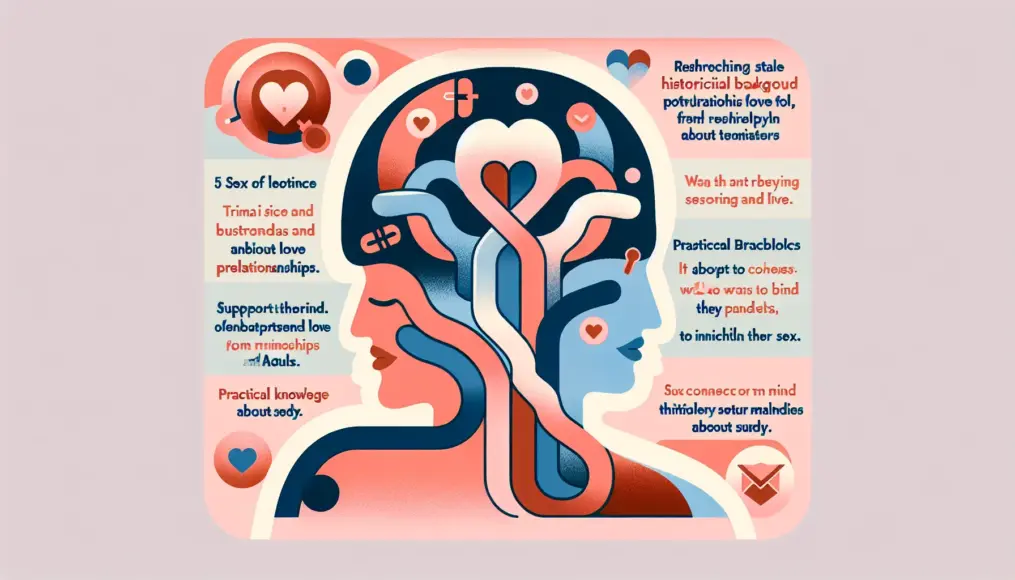At first glance, a man’s tendency to “climb on top” may seem like nothing more than physical contact. However, there’s often a complex psychological layer beneath this behavior. By delving into the reasons behind why men act this way, we may uncover insights that can lead to deeper relationship building. In this article, we’ll explore the underlying motivations of men’s actions and examine their hidden needs.
Understanding your partner’s psychology is crucial in any romantic relationship. By grasping the nuances of male psychology, you can enhance the quality of your communication and foster a stronger bond. So, let’s dive into this fascinating topic together!
- Analyzing the psychological background of men’s “climbing on top” behavior
- Exploring the hidden needs behind this behavior
- Introducing practical approaches to deepen relationships
Understanding the Psychology Behind Men’s “Climbing On Top” Behavior
At first glance, a man’s behavior of “climbing on top” might seem like a simple act of physical contact. However, there is often a deeper psychological context at play. To fully comprehend this behavior, it’s crucial to consider psychological perspectives as well as cultural and social influences. In this section, we will explore the meanings behind this behavior and the factors that shape it.
The Psychological Meaning Behind the Behavior
From a psychological standpoint, a man’s tendency to “climb on top” can be linked to desires for comfort and dominance. Many men tend to prefer physical contact as a way to feel closeness and intimacy. This behavior often manifests as an expression of seeking an emotional connection with their partner. It can also signify a sense of trust and security towards the other person.
Moreover, physical contact serves as a means for men to express their emotions. For those who may struggle with verbal communication, actions can become a way to convey feelings, which explains why this behavior is observed.
- Men’s behavior is influenced by desires for comfort and dominance
- Physical contact expresses intimacy
- Conveying emotions through non-verbal means
Cultural and Social Influences on Behavior
Cultural and social backgrounds also play a significant role in influencing a man’s “climbing on top” behavior. For instance, in certain cultures, men are often portrayed as strong figures, and these cultural expectations can reflect in their actions. Additionally, societal roles and stereotypes cannot be overlooked as factors that shape male behavior.
The societal expectations of “masculinity” can sometimes promote physical superiority and dominant behavior. As a result, men may engage in “climbing on top” actions to assert their strength. Understanding these cultural contexts can provide deeper insights into male behavior.
- Cultural perceptions of masculinity influence behavior
- Social roles impact actions
- Expectations of masculinity can encourage certain behaviors
Hidden Needs Behind Male Behavior
When men exhibit behaviors such as “taking charge” in a relationship, it goes beyond mere physical contact; it reflects deeper needs that are often hidden beneath the surface. This behavior is intertwined with a desire for security, control, and emotional connection. By understanding the emotions and needs that drive these actions, we can foster better communication and build stronger relationships. In this chapter, we will delve into the hidden needs behind male behavior.
The Connection Between Security and Control
At times, men have a desire to assert their dominance over their partners. This urge for control is closely linked to feelings of security. When they feel “on top,” men gain confidence in their relationship and experience a sense of safety. Particularly, the act of physically “taking charge” can be seen as a way for them to showcase their presence and strength, which is often a unique psychological trait of men.
Such actions serve as a means to strengthen their bond with their partner. Their strong desire for control often translates into behaviors that provide reassurance to the other person. In essence, the act of “taking charge” is not just a reflection of desire, but a deliberate intention to deepen the relationship.
- Men’s desire for control is linked to feelings of security
- Physical dominance brings confidence
- Actions serve as a way to reinforce relationships
The Male Psychological Quest for Emotional Connection
For many men, physical contact is a vital way to seek emotional intimacy. The behavior of “taking charge” extends beyond simple physical interaction; it embodies a desire to feel closer to their partner. Through such actions, men aim to express their feelings and strengthen their bond.
Moreover, men who seek emotional connection often wish to bridge the distance between themselves and their partners to cultivate a deeper relationship. Physical contact serves as a means to express emotions that words may not fully convey, thereby enhancing trust between partners. Understanding the psychology of men and recognizing the needs behind these behaviors can lead to more effective communication.
- Physical contact promotes emotional connection
- Men seek intimacy by closing the distance
- Actions contribute to strengthening trust
Understanding Male Psychology: Essential Insights for Women
Grasping the behaviors and mindsets of men is a crucial step toward enhancing romantic relationships. One common behavior that often raises questions is the tendency for men to “take charge” in conversations and interactions. This behavior is deeply rooted in a unique male communication style and nonverbal cues. In this section, we’ll delve into the fundamental aspects of male psychology that women should be aware of, focusing on how to interpret communication styles and nonverbal signals.
Male Communication Style
Men typically exhibit a straightforward and clear communication style. Many men prioritize problem-solving and concrete conclusions, often expressing their feelings more through actions and attitudes rather than words. As a result, they frequently convey their emotions through physical contact or behavior, rather than verbalizing them.
This communication approach can sometimes lead to misunderstandings. When women take men’s words or actions at face value, it can result in unintended emotional disconnects. By understanding how men communicate, women can facilitate better dialogue and gain insights into their partner’s psychology.
- Men prefer direct and clear communication.
- They often express emotions through actions and attitudes.
- It’s essential to understand the intentions behind their words.
Interpreting Nonverbal Cues
Nonverbal cues are an important tool for understanding male psychology. Body language, facial expressions, and forms of physical contact convey more information than words alone. Specifically, the behavior of “taking charge” is often interpreted as a sign of familiarity and trust toward the other person.
Being able to interpret a man’s nonverbal signals can deepen your understanding of his feelings and help build a stronger relationship. For instance, if he leans in or maintains eye contact, it typically signifies interest and engagement. By recognizing these signals, you’ll be better equipped to connect with his emotions.

If you found this article interesting, you might also enjoy “What Women Really Think About Men They Like: Key Points to Know.” Understanding how women perceive men can provide valuable insights into building better relationships.
- Nonverbal cues are vital for understanding psychology.
- Body language and expressions offer critical information.
- Deciphering these signals can smooth the path to stronger relationships.
A Practical Approach to Deepening Relationships
When it comes to the behavior of men who tend to “take the lead,” there are various psychological factors at play. Understanding these elements is essential for deepening relationships, and adopting a practical approach can make a significant difference. Open dialogue is key to grasping each other’s feelings and building a stronger connection. Additionally, using effective communication techniques can further strengthen your bond with your partner. In this section, we will delve into these approaches in detail.
The Importance of Open Dialogue
Open dialogue is crucial for establishing trust. Men sometimes struggle to articulate their feelings, but having open discussions can help both parties understand each other’s intentions and emotions. For instance, if a man exhibits “taking the lead” behavior, asking about the reasons and context behind it can provide deeper insights into his mindset.
Moreover, open discussions serve as a platform for sharing each other’s needs and desires. By expressing your own emotions candidly, you create a safe space for your partner to share their feelings as well. This mutual understanding can pave the way for a more intimate relationship.
- Open dialogue is key to building trust
- Helps in understanding each other’s intentions
- A vital space for sharing mutual needs
Communication Techniques to Enhance Relationship Building
To improve the quality of communication, incorporating some effective techniques can be beneficial. First, practicing active listening is essential. By genuinely paying attention to what your partner is saying and showing empathy, you can achieve a deeper understanding. Make it a point to provide thoughtful feedback to encourage your partner to express their feelings more openly.
Additionally, it’s important to be mindful of non-verbal cues. Observing your partner’s facial expressions, posture, and tone of voice can help you grasp emotions that may not be verbally expressed. This awareness can lead to better communication and ultimately assist in deepening your relationship.
- Practice active listening
- Pay attention to your partner’s non-verbal cues
- Thoughtful feedback enhances understanding
Summary
The behaviors exhibited by men often have psychological underpinnings and hidden needs. Factors such as the desire for security, a need for control, and emotional connections can drive these actions. By gaining a deeper understanding of these motivations, we can foster better communication and build stronger relationships.
Additionally, being able to interpret a man’s communication style and nonverbal cues is crucial for understanding his mindset. Emphasizing open dialogue and incorporating effective communication techniques can significantly enhance your relationship.
- Men’s behaviors are influenced by their need for security and control
- Understanding communication styles and nonverbal signals is essential
- Building trust through open dialogue aids in relationship development
As you deepen your understanding, you’ll be able to create more meaningful connections. We encourage you to use this article as a reference, and we’d love to hear your thoughts and experiences in the comments!









Comment